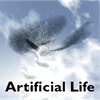Artificial Life, launched in the fall of 1993, has become the unifying forum for the exchange of scientific information on the study of artificial systems that exhibit the behavioral characteristics of natural living systems, through the synthesis or simulation using computational (software), robotic (hardware), and/or physicochemical (wetware) means. Each issue features cutting-edge research on artificial life that advances the state-of-the-art of our knowledge about various aspects of living systems such as:Artificial chemistry and the origins of lifeSelf-assembly, growth, and developmentSelf-replication and self-repairSystems and synthetic biologyPerception, cognition, and behaviorEmbodiment and enactivismCollective behaviors of swarmsEvolutionary and ecological dynamicsOpen-endedness and creativitySocial organization and cultural evolutionSocietal and technological implicationsPhilosophy and aestheticsApplications to biology, medicine, business, education, or entertainment.
1993年秋季成立的人工生命组织,已经成为一个统一的论坛,通过使用计算(软件)、机器人(硬件)和/或物理化学(湿件)手段的合成或模拟,交流关于人工系统研究的科学信息,这些人工系统表现出自然生命系统的行为特征。每一期都以人工生命的前沿研究为特色,推动了我们对生命系统各个方面的知识的发展,例如:人工化学和生命的起源自组装、生长和发育自复制和自修复系统和合成生物学感知、认知和行为具身性和创造性群体的集体行为进化和生态动力学开放性和创造性社会组织和文化进化社会和技术含义哲学和美学在生物学、医学、商业、教育或娱乐方面的应用。
Reinforcement Learning for Improving Agent Design
来源期刊:Artificial LifeDOI:10.1162/artl_a_00301
Artificial Gene Regulatory Networks—A Review
来源期刊:Artificial LifeDOI:10.1162/artl_a_00267
Towards Computational Models and Applications of Insect Visual Systems for Motion Perception: A Review
来源期刊:Artificial LifeDOI:10.1162/artl_a_00297
Evolutionary Innovations and Where to Find Them: Routes to Open-Ended Evolution in Natural and Artificial Systems
来源期刊:Artificial LifeDOI:10.1162/artl_a_00290
Open-Ended Technological Innovation
来源期刊:Artificial LifeDOI:10.1162/artl_a_00279
Why Open-Endedness Matters
来源期刊:Artificial LifeDOI:10.1162/artl_a_00294
Open-Ended Evolution and Open-Endedness: Editorial Introduction to the Open-Ended Evolution I Special Issue
来源期刊:Artificial LifeDOI:10.1162/artl_e_00282
Cardinality Leap for Open-Ended Evolution: Theoretical Consideration and Demonstration by Hash Chemistry
来源期刊:Artificial LifeDOI:10.1162/artl_a_00283
An Overview of Open-Ended Evolution: Editorial Introduction to the Open-Ended Evolution II Special Issue
来源期刊:Artificial LifeDOI:10.1162/artl_a_00291
Two Modes of Evolution: Optimization and Expansion
来源期刊:Artificial LifeDOI:10.1162/artl_a_00277
Maximum Individual Complexity is Indefinitely Scalable in Geb
来源期刊:Artificial LifeDOI:10.1162/artl_a_00285
On the Potential for Open-Endedness in Neural Networks
来源期刊:Artificial LifeDOI:10.1162/artl_a_00286
Evolving Complexity in Prediction Games
来源期刊:Artificial LifeDOI:10.1162/artl_a_00281
Open-Endedness for the Sake of Open-Endedness
来源期刊:Artificial LifeDOI:10.1162/artl_a_00289
Evolved Open-Endedness, Not Open-Ended Evolution
来源期刊:Artificial LifeDOI:10.1162/artl_a_00276
How to Make Swarms Open-Ended? Evolving Collective Intelligence Through a Constricted Exploration of Adjacent Possibles
来源期刊:Artificial LifeDOI:10.1162/artl_a_00288
Examining Community Stability in the Face of Mass Extinction in Communities of Digital Organisms
来源期刊:Artificial LifeDOI:10.1162/artl_a_00272
MetaChem: An Algebraic Framework for Artificial Chemistries
来源期刊:Artificial LifeDOI:10.1162/artl_a_00315
Nanoscale Robots Exhibiting Quorum Sensing
来源期刊:Artificial LifeDOI:10.1162/artl_a_00293
Escalation of Memory Length in Finite Populations
来源期刊:Artificial LifeDOI:10.1162/artl_a_00278
Open-Ended Evolution and a Mechanism of Novelties in Web Services
来源期刊:Artificial LifeDOI:10.1162/artl_a_00287
Moderate Environmental Variation Across Generations Promotes the Evolution of Robust Solutions
来源期刊:Artificial LifeDOI:10.1162/artl_a_00274
The MODES Toolbox: Measurements of Open-Ended Dynamics in Evolving Systems
来源期刊:Artificial LifeDOI:10.1162/artl_a_00280
Circular Causation, Circular Cognition: A Tour Around Some Common Confusions
来源期刊:Artificial LifeDOI:10.1162/artl_a_00300
Can Signal Delay be Functional? Including Delay in Evolved Robot Controllers
来源期刊:Artificial LifeDOI:10.1162/artl_a_00299
Reviewers for Volume 24
来源期刊:Artificial LifeDOI:10.1162/artl_e_00275
Mapping the Peaks: Fitness Landscapes of the Fittest and the Flattest
来源期刊:Artificial LifeDOI:10.1162/artl_a_00296
Exploring Bipedal Hopping through Computational Evolution
来源期刊:Artificial LifeDOI:10.1162/artl_a_00295
Long-Term Progress and Behavior Complexification in Competitive Coevolution
来源期刊:Artificial LifeDOI:10.1162/artl_a_00329
Self-Organization and Artificial Life
来源期刊:Artificial LifeDOI:10.1162/artl_a_00324
Toward Open-Ended Fraternal Transitions in Individuality
来源期刊:Artificial LifeDOI:10.1162/artl_a_00284
Spatial Structure Can Decrease Symbiotic Cooperation
来源期刊:Artificial LifeDOI:10.1162/artl_a_00273
Introduction to the ECAL 2017 Special Issue
来源期刊:Artificial LifeDOI:10.1162/artl_a_00298
Measuring Time with Minimal Clocks
来源期刊:Artificial LifeDOI:10.1162/artl_a_00303
Evolving Complexity in Cooperative and Competitive Noisy Prediction Games
来源期刊:Artificial LifeDOI:10.1162/artl_a_00302




